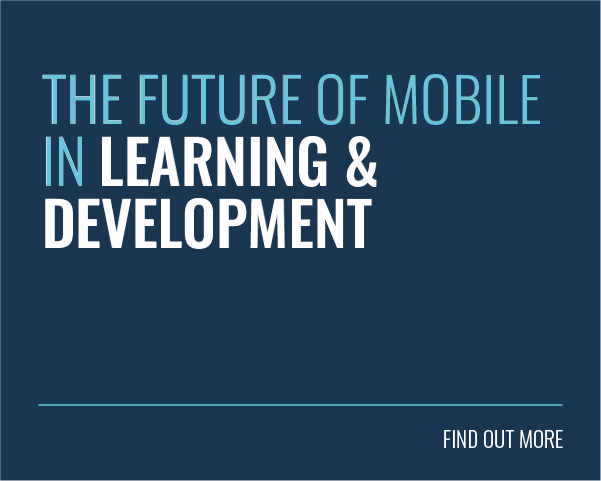 Nearly 1 in 4 people abandon an app after one use. This shows us that the old adage is true: first impressions count.
Nearly 1 in 4 people abandon an app after one use. This shows us that the old adage is true: first impressions count.
This is also true in the world of learning and development. Your learners have to want to keep returning to their training environment again and again.
If you can’t encourage repeat visits, all the time and effort you put into your learning solution will be lost.
Information won’t become knowledge, knowledge won’t be reinforced and learner behaviour won’t be changed.
Luckily, we’ve collated the top seven examples of how to use a mobile learning app to guarantee your learners are engaged and hungry to learn. Oh yeah, did we mention they’re magnificent?!
1. How to Use a Mobile Learning App in a Classroom Environment
Combining a face-to-face classroom environment with a mobile learning app is an example of blended learning. It mixes the old with the new to give the learner a truly unique experience, and has various added benefits.
So how do you use a mobile learning app in a classroom environment?
- Before the Class:
The teacher, or facilitator, can create a buzz around the forthcoming classroom event. Enthusiasm can be built by sharing content around the subject matter via the app’s social wall. Alternatively, the facilitator can set up a social club whereby the content timetable is shared. This will hopefully lead to pre-classroom discussions between your learners. Who knows, it may even encourage some eager attendees to research the topics before you even begin.
- During the Class:
Learning apps can also be used to squeeze more out of a class during training. For example, you can hold live quizzes to analyse how much info learners have taken onboard at the end of a lesson. Quizzes are a great opportunity for you to evaluate the progress of your class and to acknowledge any knowledge gaps.
With The Knowledge Arcade, admins can later write in-depth explanations for any incorrect answers.
- Post Class:
Dissecting and discussing the lessons can help iron out any lingering questions learners may have and build strong connections between colleagues. Research shows that having a good friend at work can boost engagement levels by 50%. Again, with The Knowledge Arcade, admins can create clubs to accommodate post class questions.
2. How to Use a Mobile Learning App to Build knowledge Retention
Spaced repetition is the best medicine in the fight against the Forgetting Curve. Herman Ebbinghaus’ famous Forgetting Curve theory claims that we forget 90% of what we learn within one month. However, Ebbinghaus also discovered that the more that information is reinforced, the more we remember.
When you want to access small chunks of training whilst on the go, there really is no better device than your smartphone. The condensed nature of microunits means that if the learner needs to, they can reabsorb the module with ease. In time, this will build knowledge retention.
As an admin, you can create microunits that take between 1-5 minutes to consume – ideal for building knowledge retention. For example, learners can utilize commutes to and from work by revising the content already stored on their mobile learning app.
3. How to Use a Mobile Learning App to Build Company Culture
Company culture helps to cultivate and sustain the beating heart of every business – the people. In fact, more than 50% of executives say a corporate culture influences productivity, creativity, profitability, firm value and growth rates.
Company culture is not just about free donuts and dress down Fridays. It’s about your workforce knowing and expressing your company’s values. So, how do you use a mobile learning app to build your company culture? You do so through the power of communication.
For example, clubs are digital discussion groups that can be created around any topic. It’s a forum in which colleagues from every department and every level can freely mingle. It works just as social networks do. Breaking down communication barriers is the key to building your company culture.
4. How to Use a Mobile Learning App to Build a Social Learning Culture
As the 70:20:10 model tells us, 20% of what we learn comes from others.
A learning app is built to house and encourage this type of spontaneous learning. For instance, The Knowledge Arcade has a social wall where learners can post learning videos, links to PDFs, audio files, whitepapers, infographics and anything else that will help colleagues on their learning journey.
Another great way to drive a social learning culture is by encouraging some friendly competition. Research suggests that competition can motivate, inspire more effort, and achieve better results amongst colleagues.
Battles are a relatively new learning asset unique to Growth Engineering that help to create fun rivalries between colleagues. With Battles, admins create sets of questions on a certain topic and share them between learners. Each learner can request to battle with a colleague of their choice. To make things really interesting, the results are then shown on digital leaderboards.
Admins can offer-up prizes for the winners of different categories. This can include awarding a virtual badge for winning five Battles in a row (otherwise known as a streak).
5. How to Use a Mobile Learning App to Deliver Training at the Point of Need
Let’s say It’s 4pm, and you receive an emergency email from the big boss to say all colleagues will be tested on their product knowledge in the morning. No need to jump out of the window in panic! With a mobile learning app, you can deliver your training at the point of need.
Having the benefit of accessing this info on demand is what we refer to as just in time learning. Signal/data permitted, you can upload and absorb content anywhere. You can also practice push and pull learning to remind learners to read/watch/listen to your content. With training this accessible, there are no more excuses for knowledge gaps!
6. How to Use a Mobile Learning App to Deliver a Training Campaign
Learning requires more than consuming content – it needs to be understood too. To drive this understanding, your content needs to be regularly reinforced and contextualised. This is where learning campaigns come into play.
Learning campaigns promote microlearning by breaking your modules down into daily/weekly/monthly installments.
Learning campaigns are great for initiating behaviour change as they gently reinforce the changes week-by-week through spaced repetition. You can use The Knowledge Arcade to create a detailed learning campaign to ensure your training content reaches your learners at the right time to drive maximum levels of knowledge uptake.
7. How to Use a Mobile Learning App to Engage Your Staff
Smartphones have already got the lion’s share of our attention, so they’re pretty engaging already! In fact, American consumers look at their phones 52 times a day.
So how can you use a mobile learning app to engage your learners even further? One way is by introducing gamification. According to Gartner, gamification is ‘the use of game mechanics and experience design to digitally engage and motivate people to achieve their goals’.
Using gamification throughout an online learning solution brings the same feeling of excitement that gamers feel when playing games to the learning experience.
Gamified elements such as experience points, (XPs), virtual badges, leaderboards and levels can all help make training an immersive experience. The Knowledge Arcade app allows staff to be in competition with each other wherever they are. You can even implement a reward scheme for those who level up and reach the top of the leaderboards. This can be virtual rewards such as badges and experience points, or real life rewards such as team lunches.
Final Word
Modern mobile learning apps can revolutionise the way we learn, but only if they’re used properly. In order to get the most out of your organisation’s learning app, you’ll need to know a few ‘how to’s’.
Knowing how to blend the technology of a learning app with the traditional model of a classroom environment is just one. Using the varied communication features of a learning app to build a robust social learning culture is another.
A big part of a successful training plan is engagement. By enforcing engaging learning techniques such as gamification and microlearning, your learners will be hungry to train. The Knowledge Arcade incorporates all of this and makes learning engaging and exciting. This is the key to long-lasting behaviour change.




